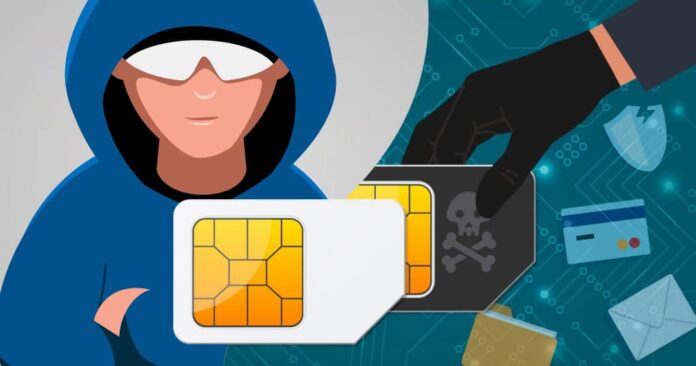SIM swap scams are a form of cybercrime that occurs when an attacker takes over the target’s cellphone number porting it to a different device in order to gain access to personal information and resources. This type of attack is becoming increasingly popular due to its simplicity, but with the proper knowledge and preparation, it can be avoided.
By getting educated in the methods attackers use, you can not only protect yourself but arm others around you with information that could help them as well.
Phishing

Phishing is one of the most widely used SIM swap scams. When a criminal is phishing, they send out spoof emails pretending to be from a legitimate provider, requesting personal data or login information. Phishing attempts can be hard to detect because they often mimic the design of some of the well-known providers, like banks or phone companies.
It is very important to be skeptical when faced with any email that requests sensitive personal or financial information and never click links or download attachments that are included in such emails. Additionally, ensure your website address starts with “https” (rather than just “http”) and that there is an icon in the address bar that looks like a padlock before submitting any sensitive information online.
Additionally, use two-factor authentication if possible as an extra layer of security for online accounts.
Social Engineering

Social engineering is a form of SIM swap scam that involves getting people to reveal personal or sensitive information. It often begins with an attacker studying a victim’s online activity and interactions, such as on social media. The attacker then contacts them pretending to be from a reputable company, claiming that their account has been compromised and that they need to reset their credentials as a security measure. Once the victim provides the initial information, the attacker will continue to build trust and exploit the situation until they have access to enough sensitive details to allow them to perform a SIM swap.
Porting Fraud
Porting fraud, also known as SIM swap fraud, is an increasingly common type of scam in which your phone number is transferred to a new SIM card owned by the criminal. This allows the cyber crooks to gain control of your phone number and all the messages, account reset links, and security information that come with it.
Once a hacker has access to your account, they will often use it to steal money from your banking accounts or even transfer out cryptocurrency holdings. It’s also possible for fraudsters to gain access to sensitive personal data such as medical records, tax returns, and photos stored in the cloud.
How To Avoid SIM Swap Scams

SIM swap scams are a growing form of identity theft and can lead to loss of access to phones and accounts. Luckily, there are a few simple steps you can do to protect yourself against this type of fraud.
Use two-factor authentication
Two-factor authentication (2FA) is an extra layer of security designed to protect your online accounts, especially those that contain sensitive data such as financial information. Implementing 2FA on accounts will help protect them in the event of an attempted SIM swap scam by creating an additional barrier to entry.
Setting up two-factor authentication requires both you and the attacker to verify a shared secret. Usually, this is done in the form of a security code that’s sent to your phone or a text message sent to a trusted number for verification. The code validates that the phone on which it was received is actually yours and not someone else’s who may have swapped SIM cards.
It can also be used with other user verification methods, such as biometric methods (fingerprint scan or facial recognition). During the setup process, you will be asked to set up two types of 2FA codes: the standard one-time password (OTP) and the backup two-factor authentication code (TBF).
The OTP code is used when accessing an account directly, while TBF is used in situations where you may be logged into an account but need to verify yourself again, such as if you get logged out due to suspicious activity. Having both types of codes used together helps ensure greater security since verification through both codes acts as another layer of defense against potential intruders trying to access your accounts using stolen or swapped SIM cards.
Monitor your accounts

Monitoring your accounts is one of the most important things you can do to keep yourself safe from SIM swap scams. Regularly check all of your online accounts and credit card charges for any suspicious activity. Pay particular attention to your mobile phone’s call history and check it regularly for any unrecognised numbers or contacts.
You should also stay aware of any recent headlines related to data breaches or other cyberattacks and be sure to change your passwords whenever possible. Additionally, look out for emails or texts that might be coming from a scammer, and never click on links in suspicious messages. If you believe you have been the target of a SIM swap scam, contact your network provider immediately. You should also consider consulting an identity theft protection company that can provide additional resources to help protect against these scams in the future.
Secure your SIM card

Secure your SIM card by registering it with your service provider and choose a passcode or PIN that only you know. Ensure that any SMS containing private information isn’t sent to accessible locations like an email address, and make sure that no one else has access to your mobile phone. It’s also important to ensure you download security applications on your device, like Find My Phone or Lookout Mobile Security for additional protection. You should also consider backing up the data on your phone regularly in case of theft or damage.
Conclusion
In conclusion, understanding these common SIM swap scams and knowing how to protect yourself from becoming a victim is important. Remember to always be on alert for any suspicious activity involving your phone, number, and identity theft. If someone tried to gain access to your phone without your knowledge via SIM swapping, make sure you contact the local authorities immediately and seek help from qualified professionals. Taking the necessary measures to protect your electronic devices and accounts will also help you safeguard yourself from future malicious activities like SIM swapping.









